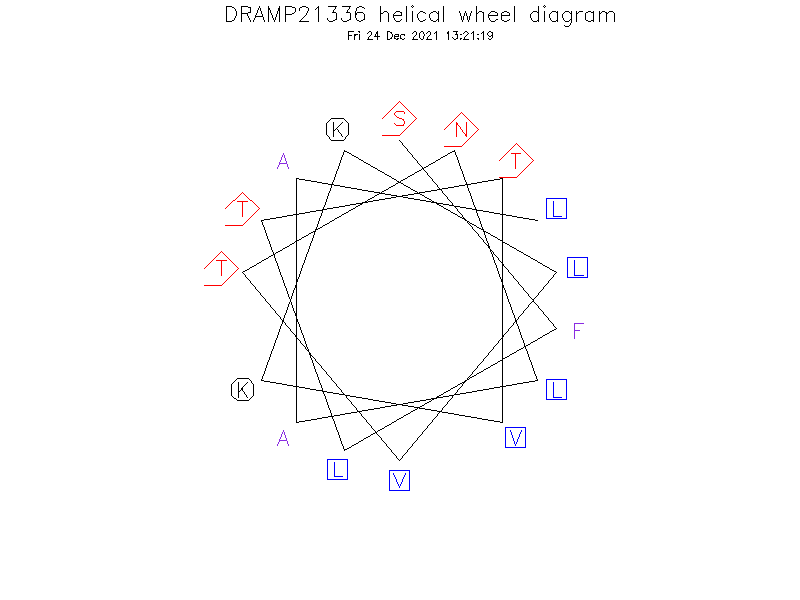General Information
-
DRAMP ID
- DRAMP21336
-
Peptide Name
- RPb (Frogs, amphibians, animals)
-
Source
- synthetic construct
-
Family
- Not found
-
Gene
- Not found
-
Sequence
- SFLTTVKKLVTNLAAL
-
Sequence Length
- 16
-
UniProt Entry
- No entry found
-
Protein Existence
- Synthetic form
Activity Information
-
Biological Activity
- Antimicrobial, Antibacterial, Anti-Gram+, Anti-Gram-, Antifungal
-
Target Organism
-
- [Ref.31242693] Gram-positive bacteria:Staphylococcus aureus (MIC=8 μM; MBC=8 μM), MRSA (MIC=16 μM; MBC=32 μM), Enterococcus faecalis (MIC=32 μM; MBC=128 μM);
- Gram-negative bacteria: Escherichia coli (MIC=16 μM; MBC=16 μM), Pseudomonas aeruginosa (MIC=64 μM; MBC=256 μM);
- Fungi: Candida albicans (MIC=16 μM; MBC=16 μM)
-
Hemolytic Activity
-
- [Ref.31242693] 7% hemolysis at 16 μM, 18% hemolysis at 32 μM, 20% hemolysis at 64 μM, 40% hemolysis at 128 μM, 70% hemolysis at 256 μM, 100% hemolysis at 512 μM on horse erythrocytes.
-
Cytotoxicity
-
- [Ref.31242693] RPb only possessed inhibitory effect on the proliferation of H157 with the IC value of 6.856 μM, while showed no inhibitory effect on the proliferation of MCF-7, U251MG, PC-3 and MDA-MB-435s. DETAILED DATA: ①The cell viabillity of NCI-H157 induced by RPb is 98.7%, 102.5%, 96.9%, 98.1%, 38.1%, 9.4% at peptide concentrations of 0.001, 0.01, 0.1, 1, 10, 100 μM, while the cell viability induced by Melittin is 100%, 95%, 89.4%, 41.2%, 16.2% and 16.2% at 0.001, 0.01, 0.1, 1, 10, 100 μM. ②The cell viability of MCF-7 induced by RPb is 100.6%, 92.5%, 90%, 99.4%, 36.2% and 11.2% at peptide concentrations of 0.001, 0.01, 0.1, 1, 10, 100 μM, , while the cell viability induced by Melittin is 100%, 98.1%, 92.5%, 7.5%, 8.7% and 8.7% at 0.001, 0.01, 0.1, 1, 10, 100 μM. ③The cell viability of U251-MG induced by RPb is 105%, 103.1%, 109.4%, 102.5%, 105.6% and 13.1% at peptide concentrations of 0.001, 0.01, 0.1, 1, 10, 100 μM, while the cell viability induced by Melittin is 99.4%, 99.4%, 75.6%, 18.7%, 11.9% and 18.1% at 0.001, 0.01, 0.1, 1, 10, 100 μM.④The cell viability of PC-3 induced by RPa is 108.8%, 103.8%, 118.1%, 125.6%, 116.9% and 68.8% at peptide concentrations of 0.001, 0.01, 0.1, 1, 10, 100 μM, while the cell viability induced by Melittin is 110%, 113.1%, 109.4%, 33.1%, 16.9% and 16.2% at 0.001, 0.01, 0.1, 1, 10, 100 μM. ⑤The cell viability of MDA-MB-435S induced by RPa is 98.1%, 95%, 100.6%, 97.5%, 80.6% and 43.1%, while the cell viability induced by Melittin is 100%, 93.1%, 82.5%, 18.8%, 18.8% and 18.1%.
-
Binding Target
- Not found
Structure Information
-
Linear/Cyclic
- Linear
-
N-terminal Modification
- Free
-
C-terminal Modification
- Amidation
-
Nonterminal Modifications and Unusual Amino Acids
- None
-
Stereochemistry
- L
-
Structure
- 49.6% Helix, 7.6% antiparallel, 0% parallel, 9.8% turn and 33% others in 50% TFE/H2O. ##0.3% Helix, 25.4% antiparallel, 0% parallel, 19.4% turn and 55
-
Structure Description
- Not found
-
Helical Wheel Diagram
-
PDB ID
- None
-
Predicted Structure
- There is no predicted structure for DRAMP21336.
Physicochemical Information
-
Formula
- C80H139N19O22
Absent Amino Acids
- CDEGHIMPQRWY
Common Amino Acids
- L
Mass
- 1719.1
PI
- 10
Basic Residues
- 2
Acidic Residues
- 0
Hydrophobic Residues
- 9
Net Charge
- +2
-
Boman Index
- 551
Hydrophobicity
- 0.988
Aliphatic Index
- 146.25
Half Life
-
- Mammalian:1.9 hour
- Yeast:>20 hour
- E.coli:>10 hour
Extinction Coefficient Cystines
- 0
Absorbance 280nm
- 0
Polar Residues
- 5
DRAMP21336
Comments Information
Function
- Antibacterial activity against Gram-positive bacteria and Gram-negative bacteria. Antifungal activity against Candida albicans.
Literature Information
- ·Literature 1
-
Title
- Bioevaluation of Ranatuerin-2Pb from the Frog Skin Secretion of Rana pipiens and its Truncated Analogues
-
Pubmed ID
- 31242693
-
Reference
- Biomolecules. 2019 Jun 25;9(6):249. doi: 10.3390/biom9060249.
-
Author
- Zhou, XW; Shi, DN; Zhong, RM; Ye, ZM; Ma, CB; Zhou, M; Xi, XP; Wang, L; Chen, TB; Kwok, HF

